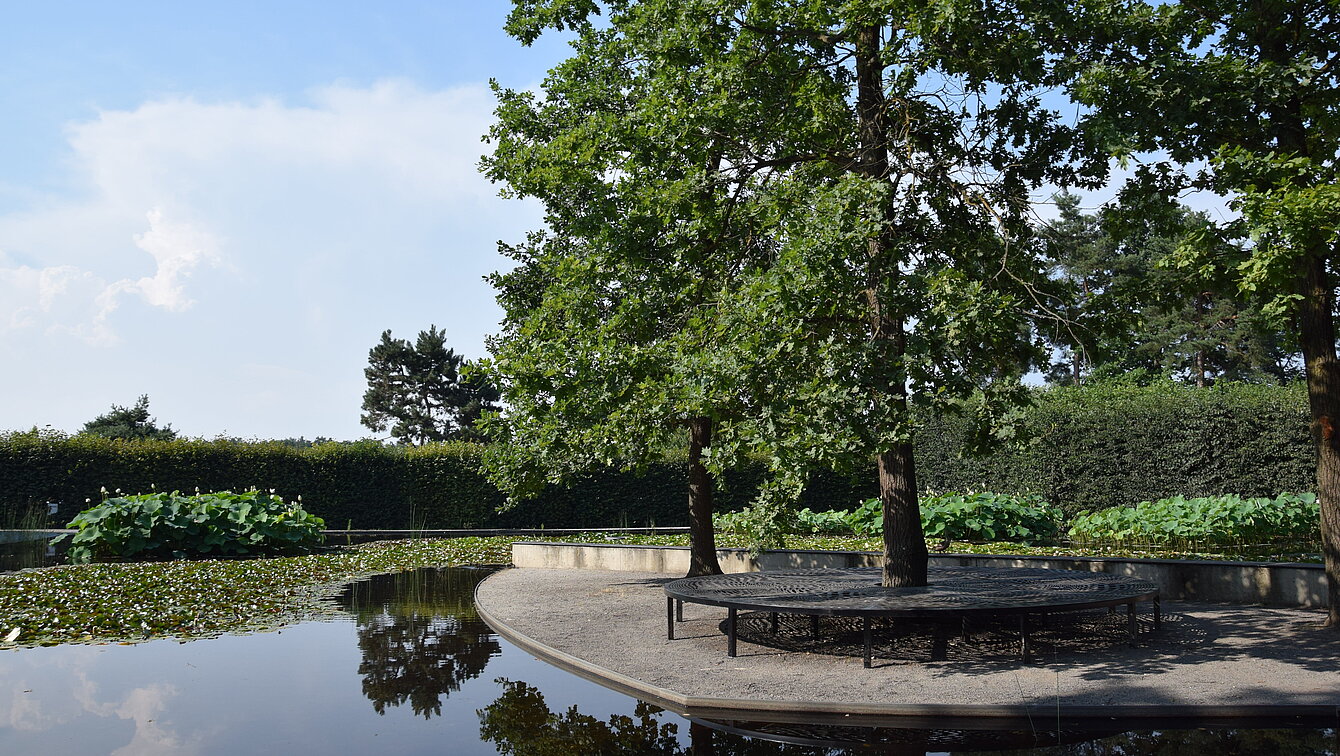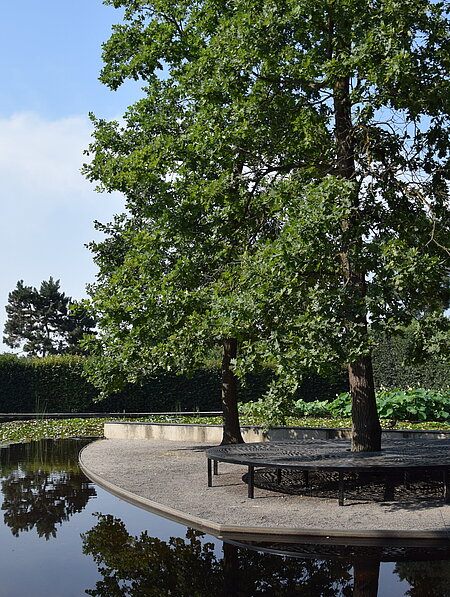Made from black, laser-processed sheet steel, this furniture sculpture stands as an autonomous work of art that also makes us want to linger here for a while. Through its diverse forms of communication, observation and application, it rejects boundaries and instead expands our field of perception and action. The sculpture is reminiscent of an elastic, permeable net, which leads to nature, art and human entering into a dialogue and engaging with each other. Together with the enclosed tree and the lotus blossom pond surrounding it, this place has a particularly harmonious atmosphere.
Untitled
Peter Kogler, 2014


Image Credits
Author
Elisabeth Fiedler
Location on map
Position 69
Owner
Österreichischer Skulpturenpark Privatstiftung
Artist biography
Peter Kogler
Show all
About the sculpture
As a conceptual-working artist, Peter Kogler has dealt with extended concepts of art, painting, film, sculpture, architecture, music, theatre and performance. Since the 1970’s, he has been especially interested in the art of Marcel Duchamp, Concept and Minimal Art or Andy Warhol, that deals with the use of subjects in seriality or the use of plain, ordinary signs and structures in a social, political and societal context. The theory of signs and the philosophy of language are also rather important for Kogler who participated at the Biennale in Venice as well as two times at the documenta.
The expansion of the concept of art was of great importance for the further development of art in Austria. It especially evolved through the Wiener Werkstätte with their tradition of opening and blurring the borders between applied arts, architecture, design and stage design as well as through its strong sense for media from the 1950’s onwards, from the avant-garde film to virtual reality.
Equally important is the artists’ interest in surface, tilting or merging into space. The three-dimensional transition of gaining independence in his „All-over“-artworks is as well-known and popular as his significant forms of the ant, the tube, and the brain.
Peter Koglers experiments with new technologies and his work on the first Macintosh computer started early in the 1980’s. He had been fascinated by the confrontation with complex machinery, which at the same time guided the user on a level of language and communication beyond the spoken word, comprehensible all over the world. He was interested in the computer as sign-instrument, which neglects emotion, hand writing and gestures and on the other hand limits it to the absolutely necessary for a general understandable legibility.
Kogler has been fond of historic expressionist films since the 1920’s, with Friedrich Wilhelm Murnau (Nosferatu, 1922), Robert Wiene (Das Cabinet des Dr. Caligari, 1920), Fritz Lang (Metropolis, 1927), of set design as well as of American art history and the „All-over“ of Jackson Pollock. Kogler is known for his reduced and intentionally comprehensible design vocabulary and dynamics, encoded in pictures, sculptures, spaces and places, in which there is a constant change between movement and easing, creating a specific vibration between biomorphic and technoid appearances in his works.
In a similar way, the present artwork “Ohne Titel” embraces a tree placed on an artificial island in the middle of the water-lily pond in the Austrian Sculpture Park. Out of mat black, powder-coated sheet steel emerges a sculpture that is as much furniture into an autonomous yet interactively inviting artwork, characterized by infinity, the ring, the area, the space without beginning nor end.
The sculpture is placed as central point in the Egyptian-inspired garden created by landscape architect Dieter Kienast. The laser cut structure of the sculpture opens the density of the steel which resembles the entanglement of nature and the movement of the waves and the water. The artists suggests to see the area as place of interaction and interwovenness but also as place of total isolation, for contemplation and observation of the sculpture from a distance.
The various forms of communication, observation and utilisation reveal limitations as illusions and extend our field of perception and action. The permeability of the sculpture, achieved by laser technology, resembles a net, an elastic material, and thus represents the interactive and dynamic process between nature, art and human.
The object represents not only the multiple coding but also multifunctionality. Graspable on various levels, we are invited to see, perceive, to sit, to keep silent or to communicate – anyways to join a dialogue. The sculpture evokes an internalized point zero of focus, similar to language in all its modalities and possibilities.



















